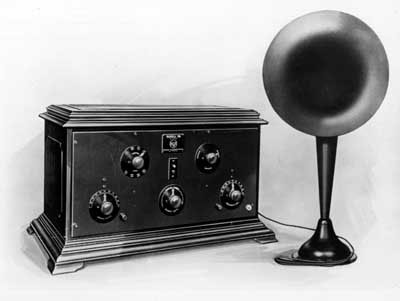
 |
Search | FAQ | US Titles | UK Titles | Memories | VaporWare | Digest | |||||||
| GuestBook | Classified | Chat | Products | Featured | Technical | Museum | ||||||||
| Downloads | Production | Fanfares | Music | Misc | Related | Contact | ||||||||
| CED in the History of Media Technology | ||||||||||||||

Radio Corporation of America was formed on October 17, 1919 from the American Marconi Co. Over the next few months it became a patent trust between AT&T, General Electric, Westinghouse, and United Fruit Co. so radios could be freely manufactured. RCA's radios during the 1920's were manufactured by GE/Westinghouse with a 60/40 split between the two companies.
David Sarnoff entered RCA as commercial manager, becoming general manager in 1921. While still at Marconi in 1916, Sarnoff had made the following prophetic statement in a company memorandum:
I have in mind a plan of development which would make radio "a household utility" in the same sense as the piano or phonograph. The idea is to bring music into the house by wireless ... The "Radio Music Box" can be supplied with amplifying tubes and a loudspeaker telephone, all of which can be neatly mounted in one box. The box can be placed on a table in the parlor or living room, the switch set accordingly, and the transmitted music received.
Being general manager at RCA gave Sarnoff the opportunity to bring his plans to fruition. An inventor named Edwin Armstrong, who Sarnoff had known for a number of years, had perfected a circuit called the superheterodyne which simplified the tuning of a radio receiver, eliminating the need for an antenna while reducing static. Upon seeing a demonstration of this receiver in 1922 Sarnoff purchased Armstrong's patents for $200,000 and 60,000 RCA shares. With patent royalties guaranteed for years to come, RCA prospered during the 1920's and was in a good position to enter television research at the end of the decade.